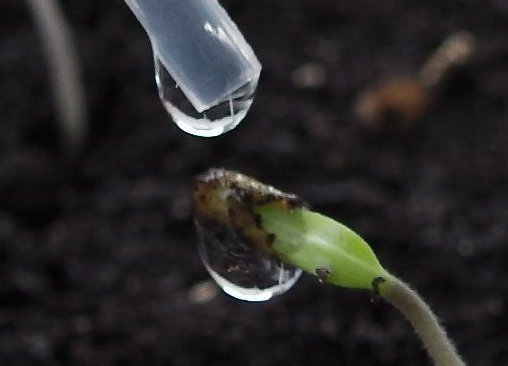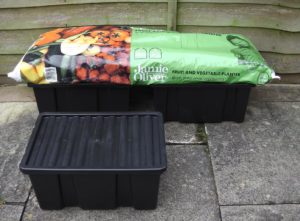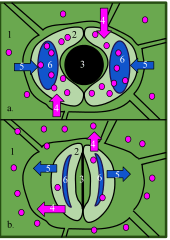Here’s a useful easy tip:

When seeds germinate they often come through with their seed shell still attached to the seed leaves.
A propagator with lid helps because it keeps the air humid and prevent the seed shells from drying out.
If the lid is kept on too long, the extra moisture makes the seedlings leggy – especially the first ones through. A dropper or pipette (as above) will help individual seedlings discard their seed shells.
A New Product On The Market
A new product that makes watering and feeding tomato plants in grow bags easier is the “Hozelock Grow Bag Waterer 2810”. Thanks Steve for mentioning it in the comments last week!
It has a reservoir of 15 litres of water and uses capillary action/matting to draw the water into the grow bag through spiked holes in the bottom. A water level indicator and a hose attachment makes this waterer a very useful addition to growing tomatoes in a grow bags.
They are available on Amazon for around £20.00.
If asked would I buy one, the answer is yes. Although the 15 litre reservoir is a bit small, there is a hose pipe attachment that could easily be used with an auto watering timer if away on holiday.
A similar system is the Quadgrow Planter that also uses capillary matting but with pots over a reservoir. It’s twice as expensive as the Hozelock but contains four pots and a 30 litre reservoir.
The advantage of any system where plants can absorb water at their own rate, and where water is always available is huge.
Money Saving Option
Of course for those who enjoy a bit of DIY, there are less expensive options.
On a recent trip to Poundland (it’s amazing what you can get for a £1.00!), I spotted a row of black storage boxes. They were next to the tools so I think they’re meant for hammers and nails etc. However, they will make great water reservoirs being light-proof and although plastic, quite strong when the lid is on.
Here’s one idea …

All that’s needed is a slot cut in the lid of each container for a strip of capillary matting. This would then go up through a cut in the grow bag. These containers are 14 litres each. No need to ask the price!
Under-bed plastic storage boxes make good low level reservoirs but it’s best to line them with black plastic to make them light-proof. Algae and other growth can be an issue where there is water, nitrogen and light.
Leaf Stomata & Foliar Spraying
Plants are like humans in as much that they have pores.
In plants the pores are called stomata and are mainly on the underside of leaves.
The stomata are used to release water vapour. As water is lost out of the leaves, water is drawn in through the roots.
Because water molecules tend to stick together, this acts as a chain from the roots to the leaves from where the water evaporates. This process is called transpiration.
Stomata also open to allow carbon dioxide into the leaves which is essential for photosynthesis – the process by which plants make their own food (sugars). Commercial greenhouses add extra carbon dioxide to the air so that plants will grow faster.
Stomata also release oxygen which is very important for us!
The stomata open and close depending on weather conditions.
When it is sunny and bright, they open to release water vapour in order to draw up water and nutrients through their roots and allow more carbon dioxide into the leaves.
Of course if leaves release too much moisture the plant wilts. If they keep their stomata closed they won’t be able to absorb carbon dioxide and that will slow growth – it’s a continual compromise.
Stress
A plant can easily become stressed if the water supply at its roots is erratic as this will affect transpiration which includes nutrient take up. A good reason to have a reservoir for the grow bag!
Stress can cause so many other issues including, blossom drop and smaller ripe fruit than expected.
Guard Cells – The Doors of the Stomata
Each stoma (singular) in the leaf has a guard cell on either side that opens and closes. They look a bit like bananas and sausages!
 The guard cells open and close by pressure – as water (including sugars etc.) is pumped into the guard cells they open the stomata (3), as pressure is reduced they close (lower photo).
The guard cells open and close by pressure – as water (including sugars etc.) is pumped into the guard cells they open the stomata (3), as pressure is reduced they close (lower photo).
This is good, because on a hot day if a plant runs low on water, the guard cells close (less pressure) and prevent more water from escaping from the leaves. Eventually, if the plant is not watered it wilts to the point of no return as the pressure within it is lost. The guard cells will be closed at this stage trying to conserve as much moisture as possible.
Top photo open – bottom photo closed.
How This Relates To My Plants
Foliar Spraying
Because most stomata (pores) are found on the underside of the leaves, it is best to foliar spray the underside of the leaves. Moisture and nutrient absorption into a plant’s system is also quickest through the underside of the leaves because of the many stomata and the cuticle (outer waxy layer) is much thinner than on the upper surface.
Spraying the upper leaf surface takes longer for nutrients to enter a plant’s system because of the thick waxy layer. However, it has been shown that nutrients are absorbed to the same amount over time (top and bottom leaf surfaces), just not at the same rate.
The problem with spraying the upper leaf surface is the danger of fungal spores landing on the leaves. Blight spores are totally harmless on a dry leaf – that’s worth remembering!
Interruption of Water Flow
Spraying leaves regularly (everyday) is not a good idea because every time a leaf is wet, the release of water vapour from the stomata slows because moisture (humidity) outside the leaf is greater than the moisture inside – making it harder for leaves to release water vapour.
This interrupts the flow of nutrients from the roots. Excessive foliar spraying could lead to deficiency of the immobile elements such as calcium and therefore cause Blossom End Rot. A foliar spray once every three or four days is the most often I would spray.
Foliar spraying/feeding is best used as a supplement – when leaves show a nutrient deficiency. Or at a time in a plant’s growth when more of a particular nutrient is needed and a deficiency is more likely to occur.
A build-up of nutrients on the leaf surface can also cause leaf damage and make further foliar spraying less effective.
To Recap:
- Spray the underside of leaves for quickest results
- Wet leaves are vulnerable to blight
- Spraying too often may interrupt nutrient supply from roots and cause BER
- Use as a supplemental feed
- Too much foliar feeding can damage leaf surfaces
Next week … how to tell the difference between nutrient deficiencies when leaves show the same symptoms.
I hope you’ve enjoyed the technical part of this newsletter. There is plenty of information out there on the internet. My aim is to try and join some of the dots and make a little of it relevant to tomato plants.
Please leave comments as usual in the section below – it was great to hear from so many people last week!
Regards,
Nick
Tomato seeds take about six or seven days to germinate in the airing cupboard.
Using a small seed tray makes it a lot easier to find a warm place – a plastic food container is ideal.
It’s very important to move seedlings as soon as they germinate into a light position to stop them from becoming leggy.
Keep the seed compost dryish – seedlings need very little water and are prone to diseases that are encouraged by wet cold soil and roots.


Catriona Ferris
Thanks Nick, so great to be talking tomatoes again – it’s been a long winter!!
Great advice on the Hozelock waterers. I have decided to treat myself to a set of 5 – predominantly to reduce the gymnastics I had to do when carefully stepping over all the Heath-Robinsonesque multi-height tubing of my drip-watering system last year! I’ll still use my drip-watering for the potted plants on the shelving, but the floor level growbags will get the capilliary system. Can’t wait!!
Note sure if my mentioning this is naughty, but to anyone thinking of purchasing via Amazon, they’re £20 + £5 P+P from the advertised seller, but if you look to the right of the screen (“More buying choices”) you’ll note Amazon actually sell & deliver them themselves for £16.94 with free delivery!! That gives you a spare £8 to buy seeds & tomato feed!!
Nick
Hi Catriona,
Not naughty at all … well spotted!
Nick
Mark Ridsdill Smith
Hi Nick
Really clear and useful info, right up my street, and I’ve learnt plenty from just two newsletters. Thank you.
I’m right with you on the value of providing a water reservoir. As a new member, I’m not sure if you’ve done much in the past on containers with water reservoirs? You can buy them (Earthboxes are the best but sadly not available in the UK anymore) or make them – there’s heaps of DIY ideas out there on the internet. One method I’ve used quite a lot is using old recycling boxes (strong and UV proof) and PVC drainage pipe (common in skips) as wicking feet. It’s a bit of a DIY job to make, but they last for years and make watering a lot easier. (Anyone interested can see an example I wrote about here: http://www.verticalveg.org.uk/diy_water_reservoir/)
Thanks again
Mark
PS I tried to email you on another subject recently, hope you got it OK?
Nick
Hi Mark,
I’m pleased you found the newsletters helpful.
Where reservoirs are concerned, I’ve mainly used the Quadgrow Planters and the Autopot easy2grow systems. A bit over-priced I think, so it’s good to come up with one or two cost-saving ideas.
The best email to contact me on is [email protected] I don’t think I received your recent email.
Regards,
Nick
Derek
Thank you very much Nick,
I too have found the information very informative, most especially the issue of spraying the underside more than the top + the frequency of spraying actually being counter productive when over done.
I look forward to sowing along with you. We enjoy tropical weather over here, but I’ll wait for you guys just to tag along for the ride and enjoy the journey.
Derek from Uganda
Rhys Jaggar
Nick
One thing you might suggest for your Sow-Along is the plastic self-assembling trays you can get in Poundland. They have four velcro strips to create four corners, so you get a tray with sides that you can use on your kitchen table to set up your seedlings/transplant the germinated seedlings into pots.
They’re really good at containing soil that may drop otherwise on the table or the floor and then you simply go and shake it outside to get rid of any crumbs. Then you ‘unzip’ them and the plastic folds up into a 20cm * 20cm square that you can store in a drawer, on top of a wardrobe or the like.
That way you can work indoors without creating a right mess.
One of the best £1 investments I’ve made.
Nick
Thanks Rhys,
I’ll certainly add them to the sow-along!
Nick
Jacqueline
Very informative, especially the illustrations, many thanks
Jacqueline
Nick
Hi Jacqueline,
I’m pleased that you found the newsletter informative
Nick
Dawn
Hi Nick
Thanks for the newsletters, very interesting and informative. I have learnt so much in a short space of time. I hope all this extra knowledge makes my tomatoes grow better this year lol…..
Cheers
Dawn
Nick
Hi Dawn,
It’s amazing how much there is to learn … there are still many things about plants that we do not yet understand. It makes it even harder when each summer gives different growing conditions.
If your tomatoes don’t do better, I’ll turn up at your door with a hundred of my best cherry tomatoes … I hope you don’t live too far away lol….
Cheers,
Nick
Sue Heyer
Hi Nick
Thanks for the new newsletters, already lots of useful tips. Am passing them on to my gardening forum in the UK, perhaps some of the members will subscribe too. Am trying some French heirloom tomatoes this year, trying to find the ones we used to get in a salad niçoise in the South of France years ago that were delicious although still partly green!
Looking forward to the next newsletter and thanks again.
Regards
Sue in Switzerland
Nick
Hi Sue,
It’s good to hear from you!
Thanks for passing on the newsletter – it’s always good to get new subscribers.
It’s amazing just how diverse tomato varieties can be. I hope you find it!
Regards,
Nick
David
Hi Nick,
I’m pleased to get your 2nd newsletter of this new growing season! I’m itching to get started sowing my seeds but I know I must wait if I don’t want to loose them like last year & sow a 2nd time!
I found your explanation of how the foliar feed is better taken up from the lower surface very interesting! I knew that foliar spay is a good way of getting supplemental feeding quickly to our plants but never knew about faster absorption from the underside.
I also found it interesting your use of the black containers as reservoirs for the administration of a constant supply of water. 🙂
I’m looking forward to future tips in your newsletters.
Nick
Hi David,
I’m pleased you found this week’s newsletter interesting … just another five weeks to go until the best sowing time for those in the UK.
Nick
mick w
Very informative newsletter nick,keep up the good work.
mick w.
Nick
Thanks Mick – I’m pleased you found the newsletter informative.
Nick
Albert Parkinson
Hi Nick,
Enjoying the newsletters already.Some really good info coming through already, can’t wait to get going once again.Had a good year last season with the help of your newsletters, not forgetting all the contributions of course from the members of our great club.I am looking forward to trying some of the new varieties this season as well as my ‘Old faithfuls’ Keep up the good work Nick, and thank you.
Good luck to all, hope you have a good year.
Nick
Hi Albert,
Thank you for your kind words … I hope you have a great season too!
Nick
kevin
HI Nick I am going away in the summer for 1 week what is the best way to water them.
Nick
Hi Kevin,
If you are growing in pots or grow bags then the easiest way is an auto timer Hozelock AC1 and a simple watering kit.
For grow bags the new Hozelock waterer is very good if you also use a timer to top it up. Or you could make something yourself.
Another option for trays is the smart or aqua valve – there are so many options!
Regards,
Nick